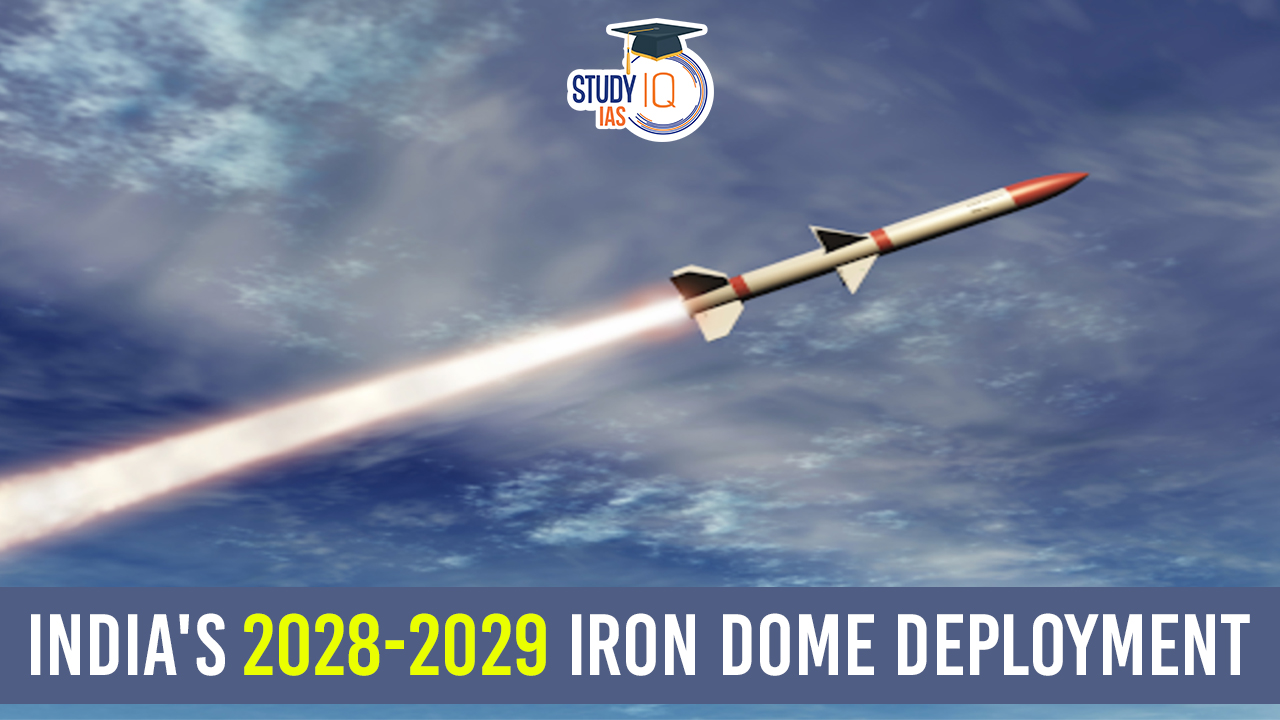Table of Contents
India Plans to Deploy Indigenous ‘Iron Dome’ by 2028-2029. The system is expected to be able to detect and destroy incoming stealth fighters, drones, cruise missiles, and munitions at ranges of up to 350 kilometers. The system is being developed by India’s Defense Research and Development Organization (DRDO) under Project Kusha. It’s expected to have interception capabilities comparable to the Russian S-400 Triumf air defense system.
India’s 2028-2029 Iron Dome Deployment
India is in the process of developing its indigenous Long-Range Surface-to-Air Missile (LR-SAM) system, similar to Israel’s Iron Dome air defense system. It is scheduled for deployment by 2028-2029 under the ambitious Project Kusha. The Cabinet Committee on Security approved the LR-SAM system as a “mission-mode” project in May 2022, and the Ministry of Defence granted acceptance of the necessity for the procurement of five squadrons for the Indian Air Force (IAF) at a cost of Rs 21,700 crore.
We’re now on WhatsApp. Click to Join
Project Kushaa
Project Kusha is a significant initiative aimed at equipping India with a robust air defense system capable of detecting and neutralizing incoming threats. The project received approval from the Cabinet Committee on Security in May 2022, designating it as a “mission-mode” project.
Acceptance of Necessity and Funding
In September, the Ministry of Defence granted the acceptance of the necessity for the procurement of five squadrons of this system for the Indian Air Force (IAF) at a cost of Rs 21,700 crore, demonstrating the government’s commitment to enhancing India’s defense capabilities.
Collaboration with Israel and Private Sector
This homegrown version of the Iron Dome is expected to significantly bolster the nation’s defense capabilities. The initiative is a joint effort between the Defense Research and Development Organisation (DRDO) and Israel Aerospace Industries (IAI), with the involvement of private sector players. India’s prior collaboration with Israel in the development of the Medium-Range Surface-to-Air Missile system (MRSAM), capable of targeting aerial assets at distances of 70 km, highlights the fruitful partnerships in defense technology.
Long-Range Surface-to-Air Missile (LR-SAM)
India’s LR-SAM (Long-Range Surface-to-Air Missile) system, similar to the Iron Dome, can detect and destroy a variety of threats within a 350-kilometer range. It boasts interception capabilities comparable to the Russian S-400 Triumf air defense system, utilizing long-range surveillance, fire control radars, and multiple interceptor missiles. Notably, it’s anticipated to have an 80% or higher success rate for single missile launches and not less than 90% for salvo launches. It can intercept fighter-sized targets at a range of 250 kilometers and larger aircraft like AWACS and mid-air refuelers at a range of 350 kilometers, enhancing India’s defense capabilities.
System Capabilities
Detect and Destroy: The system is designed to detect and eliminate a wide range of threats, including stealth fighters, aircraft, drones, cruise missiles, and precision-guided munitions, at ranges of up to 350 kilometers.
Comparable to S-400: The “interception capabilities” of this indigenous long-range surface-to-air missile (LR-SAM) system are expected to be on par with the Russian S-400 Triumf air defense system, which has recently been inducted by the Indian Air Force.
Government Approvals
Cabinet Committee on Security: The development of the LR-SAM system was approved as a “mission-mode” project by the Cabinet Committee on Security in May 2022.
Acceptance of Necessity: Last month, the Ministry of Defence granted the acceptance of necessity (AoN) for the procurement of five squadrons for the Indian Air Force, with a budget of Rs 21,700 crore.
Technical Details
Versatile Interceptor Missiles: The mobile LR-SAM system will be equipped with long-range surveillance and fire control radars and will utilize various interceptor missiles capable of hitting hostile targets at ranges of 150 kilometers, 250 kilometers, and 350 kilometers.
Reliable Area Air Defense: The LR-SAM is meant to provide reliable “area air defense” with a single-shot kill probability of not less than 80% for single missile launches and not less than 90% for salvo launches.
Comprehensive Air Defense
Coverage of Vulnerable Areas: The system’s purpose is to provide comprehensive air defense coverage for both strategic and tactical vulnerable areas.
Effective Against High-Speed Targets: According to DRDO, the LR-SAM will be effective even against high-speed targets with low radar cross-sections.
Interception Capabilities
Target Range: The LR-SAM will have the capability to intercept fighter-sized targets at a range of 250 kilometers, while larger aircraft like AWACS (airborne warning and control systems) and mid-air refuelers can be intercepted at a range of 350 kilometers.
Integration with IACCS
Integrated Air Command and Control System: The firing units of the LR-SAM can interact with the Indian Air Force’s integrated air command and control system (IACCS), a fully-automated air defense network that integrates military and civilian radars to fill surveillance gaps in Indian airspace.
Importance of India’s Long-Range Air Defense System (LR-SAM)
- Enhanced National Security: The development and deployment of the indigenous LR-SAM system are crucial for bolstering India’s national security. It provides a comprehensive air defense shield, capable of detecting and neutralizing a wide range of threats, including aerial assets like stealth fighters, drones, cruise missiles, and precision-guided munitions.
- Reduced Dependence on Foreign Systems: By investing in its own long-range air defense system, India reduces its reliance on foreign defense technologies, which enhances its self-reliance and sovereignty in defense matters. This self-sufficiency is aligned with India’s goal of becoming “Aatmnirbhar Bharat” or self-reliant.
- Strategic Flexibility: The LR-SAM’s interception capabilities comparable to the Russian S-400 Triumf air defense system offer India strategic flexibility. It allows the nation to protect its airspace effectively against various threats, from short-range to long-range, high-speed targets.
- Protection of Vulnerable Areas: The LR-SAM is designed to provide reliable area air defense, which is crucial for safeguarding both strategic and tactical vulnerable areas. This ensures the protection of key assets and regions from potential threats.
- Integration with IACCS: The integration of the LR-SAM system with the Integrated Air Command and Control System (IACCS) streamlines air defense operations. It helps fill surveillance gaps in Indian airspace by linking military and civilian radars, thus improving overall situational awareness and response capabilities.
- Collaborative Development: The collaboration with Israel Aerospace Industries (IAI) and private sector players highlights the importance of international partnerships and knowledge sharing in advancing defense technology. Such collaborations can lead to technological advancements and strengthen diplomatic ties.
- High Success Rate: The LR-SAM’s anticipated high success rates for single missile launches and salvo launches demonstrate its reliability in intercepting threats. This high effectiveness is crucial in countering evolving and complex security challenges.
- Top of Form
Long-Range Air Defense System (LR-SAM) UPSC
India’s endeavor to deploy an indigenous “Iron Dome” by 2028-2029 under Project Kusha marks a significant leap in national security. With the ability to detect and eliminate threats at a range of up to 350 kilometers, the Long-Range Surface-to-Air Missile (LR-SAM) system, comparable to the S-400, plays a pivotal role. This development reduces dependence on foreign systems, aligning with India’s self-reliance goals, offers strategic flexibility, safeguards vulnerable areas, and integrates seamlessly into the Integrated Air Command and Control System (IACCS). Collaborations with Israel and private sectors foster innovation, and high interception success rates enhance defense against evolving security challenges.


 Nipah Virus (NiV): Structure, Testing Me...
Nipah Virus (NiV): Structure, Testing Me...
 What is Ham Radio and its Purpose?
What is Ham Radio and its Purpose?
 INS Udaygiri, Key Features, Capabilities...
INS Udaygiri, Key Features, Capabilities...





















